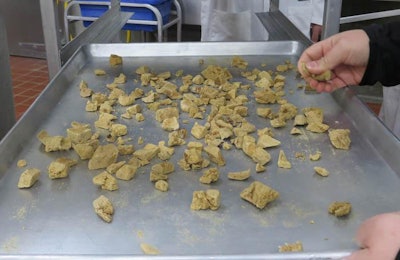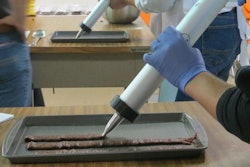
Today’s popular pet treats and pet food products using high meat levels and exotic proteins can benefit from the freeze-drying process, according to experts from the Scoular Co. In a hands-on demonstration during Petfood Innovation Workshop on September 15, held with the KSU Pet Food Experience at Kansas State University in Manhattan, Kansas, USA, participants prepared exotic proteins for freeze-drying while the experts explained the process.
While pet food professionals participating in Petfood Innovation Workshop cut up wild boar hearts and duck liver, Justin Stadden, senior business unit manager with Scoular, said that different types of protein have yield variabilities and different properties, necessitating that they be freeze-dried separately. “The rule of freeze-drying is one chamber, one meat, or one chamber, one product,” Stadden said.
Along with Taylor Wiebler, marketing manager, Stadden walked participants through a presentation on the freeze-drying process and how it transforms fresh meat products into safe, shelf-stable ingredients for pet treats and pet food products. Scoular Co. provides freeze-dried ingredients to the pet food industry and also can co-pack freeze-dried pet treats at its facility in Minnesota.
The Scoular demonstration was one of six stations offered Petfood Innovation Workshop. Others allowed participants to make pet jerky treats with kangaroo meat and faba bean protein, semi-most dog treats with a high-protein hydrolyzed powder and a meat snack with stabilized rice bran. At other stations, pet food professionals compared the functional and nutritional benefits of spray-dried plasma and learned about specialized equipment used to produce formed jerky treats.
The next edition of Petfood Innovation Workshop will take place April 3 at the KSU Olathe campus, in conjunction with Petfood Forum 2017. A new Petfood Technology Workshop Mexico debuts December 5-6, 2016, in Ensenada, Mexico.
















